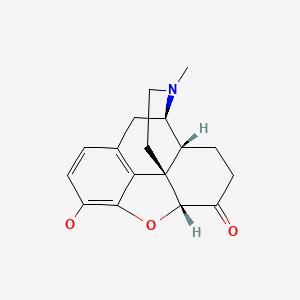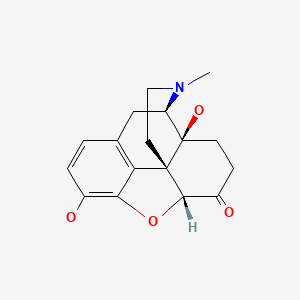NCBI Bookshelf. A service of the National Library of Medicine, National Institutes of Health.
LiverTox: Clinical and Research Information on Drug-Induced Liver Injury [Internet]. Bethesda (MD): National Institute of Diabetes and Digestive and Kidney Diseases; 2012-.

LiverTox: Clinical and Research Information on Drug-Induced Liver Injury [Internet].
Show detailsOVERVIEW
Introduction
Hydromorphone and oxymorphone are semisynthetic derivatives of morphine and potent opiate agonists which are used predominantly to treat moderate-to-severe pain. Neither hydromorphone nor oxymorphone have been linked to serum enzyme elevations during therapy or to clinically apparent liver injury.
Background
Hydromorphone and oxymorphone are semisynthetic derivatives that both act by engagement in cell surface opiate receptors (predominant µ type receptors) that are found in the central nervous system, but also heart, lung, vascular and intestinal cells. Current indications are for moderate-to-severe pain, pre- and postoperative analgesia, and as an adjunct to anesthesia.
Hydromorphone was approved for use in the United States in 1984 and is still widely used in treatment of moderate-to-severe pain not responsive to non-opioid agents. Hydromorphone is also used, in low doses, as an antitussive. Hydromorphone is available generically and under the brand name Dilaudid as tablets of 2, 4 and 8 mg, as an oral solution of 5 mg/5 mL and as suppositories of 3 mg. Extended release tablets of 8, 16, 24 and 32 mg are available for treatment of chronic pain in opioid-tolerant subjects who have severe pain requiring around-the-clock opioid therapy. Solutions for injection (1 to 10 mg/mL) are also available. The usual dose of hydromorphone for acute pain in adults is 2 to 10 mg orally every 3 to 6 hours or 2 to 4 mg by injection every 4 to 6 hours. Lower doses (1 mg orally) are used for treatment of cough.
Oxymorphone was approved for use in the United States in 1959 and remains in clinical use. Current indications are for treatment of moderate-to-severe pain, alleviation of anxiety associated with dyspnea of pulmonary edema and as an adjunct to general anesthesia and preoperative sedation. Oxymorphone is available generically and under the brand name Numorphan and Opana in standard tablets of 5 and 10 mg, suppositories of 5 mg and as a solution for injection of 1 mg/mL. Extended release tablets of 5 to 40 mg are available for use in opioid-tolerant patients with pain severe enough to require around-the-clock opioids. The usual dose of oxymorphone is 5 to 20 mg orally of the standard tablets every 4 to 6 hours or 1 to 1.5 mg by injection every 4 to 6 hours.
The side effects of hydromorphone and oxymorphone are similar to those of other opiates and include sedation, respiratory depression, confusion, euphoria, agitation, constipation, abdominal bloating, nausea, vomiting and constipation. Both drugs are controlled substances and classified as Schedule II drugs, indicating that they have medical usefulness, but also a high potential for physical and psychological dependency and abuse. Severe adverse events include life-threatening respiratory depression, addiction, abuse, opioid withdrawal, serotonin syndrome (when used with serotonergic agents) and adrenal insufficiency.
Hepatotoxicity
As with most opiates in current use, therapy with hydromorphone and oxymorphone has not been linked to serum enzyme elevations. There have been no convincing cases of idiosyncratic acute, clinically apparent liver injury attributed to either agent.
Likelihood score, Hydromorphone: E (unlikely cause of clinically apparent liver injury).
Likelihood score, Oxymorphone: E (unlikely cause of clinically apparent liver injury).
References on the safety and potential hepatotoxicity of hydromorphone and oxymorphone are given in the Overview section of the Opioids.
Drug Class: Opioids
PRODUCT INFORMATION
REPRESENTATIVE TRADE NAMES
Hydromorphone – Generic, Dilaudid®
Oxymorphone – Generic, Numorphan®, Opana®
DRUG CLASS
Opioids
COMPLETE LABELING (Hydromorphone)
COMPLETE LABELING (Oxymorphone)
Product labeling at DailyMed, National Library of Medicine, NIH
- PubChem SubstanceRelated PubChem Substances
- Review Opioids.[LiverTox: Clinical and Researc...]Review Opioids.. LiverTox: Clinical and Research Information on Drug-Induced Liver Injury. 2012
- Forensic drug testing for opiates. VI. Urine testing for hydromorphone, hydrocodone, oxymorphone, and oxycodone with commercial opiate immunoassays and gas chromatography-mass spectrometry.[J Anal Toxicol. 1995]Forensic drug testing for opiates. VI. Urine testing for hydromorphone, hydrocodone, oxymorphone, and oxycodone with commercial opiate immunoassays and gas chromatography-mass spectrometry.Smith ML, Hughes RO, Levine B, Dickerson S, Darwin WD, Cone EJ. J Anal Toxicol. 1995 Jan-Feb; 19(1):18-26.
- Review Pharmacokinetic drug interactions of morphine, codeine, and their derivatives: theory and clinical reality, part I.[Psychosomatics. 2003]Review Pharmacokinetic drug interactions of morphine, codeine, and their derivatives: theory and clinical reality, part I.Armstrong SC, Cozza KL. Psychosomatics. 2003 Mar-Apr; 44(2):167-71.
- Evidence that morphine is metabolized to hydromorphone but not to oxymorphone.[J Anal Toxicol. 2008]Evidence that morphine is metabolized to hydromorphone but not to oxymorphone.Cone EJ, Caplan YH, Moser F, Robert T, Black D. J Anal Toxicol. 2008 May; 32(4):319-23.
- Effect of morphine, methadone, hydromorphone or oxymorphone on the thermal threshold, following intravenous or buccal administration to cats.[Vet Anaesth Analg. 2016]Effect of morphine, methadone, hydromorphone or oxymorphone on the thermal threshold, following intravenous or buccal administration to cats.Pypendop BH, Shilo-Benjamini Y, Ilkiw JE. Vet Anaesth Analg. 2016 Nov; 43(6):635-642. Epub 2016 Mar 1.
- Hydromorphone - LiverToxHydromorphone - LiverTox
Your browsing activity is empty.
Activity recording is turned off.
See more...

